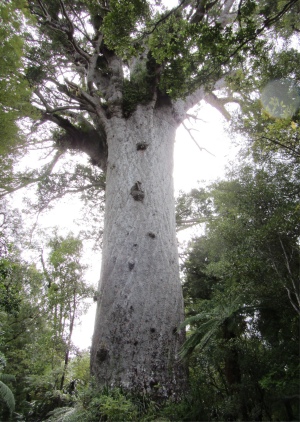 Tane Mahuta, "Lord of the Forest" |
I wandered down to the waterside to gaze across Hokianga Harbour at the massive sand dunes on the far shore. The sea separating the shores was a herd of white horses. I checked on the weather; perhaps showers in the afternoon. The east coast was suffering the brunt of this cyclone.
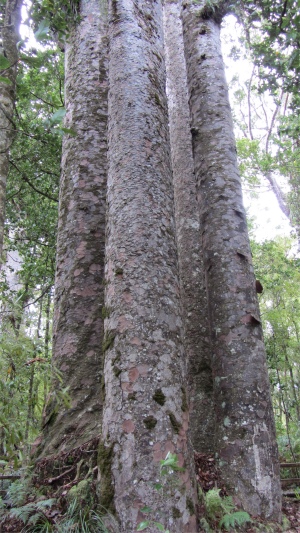 Four Sisters |
The kauri ranks alongside the Giant Sequoias of California as one of the largest trees in existence. Last summer, I visited Mariposa Grove to the south of Yosemite, California. Here I saw examples around me of sequoias that had fallen down or had been chopped down. When the trunks hit the ground, they broke up into pieces due to their brittleness. As a consequence they did not hold much value from a timber sense. The kauri, however, provides durable, easily worked, straight, fine grained, blemish-free timber. The Maori employed mature kauri for dugout canoes, and the European loggers soon latched onto the value of this timber. Initially the "rickers" (young trees) were felled in their thousands to provide masts and spars for sailing ships. Within a hundred years, less than 0.5% of the original forests were left standing. In 1952, after much public pressure and antagonism at continued milling, Waipoua and the neighbouring forests of Mataraua and Waima, which made up the largest remaining tracts of native forest, were placed under the protection of the Department of Conservation. Today, there is no milling of mature kauri trees, except under extraordinary circumstances such as for the carving of a Maori canoe. Kauri seedlings need plenty of light, so kauri trees usually begin life growing amid manuka scrubland in forest clearings formed by windfall or fire. Adolescent trees form a tapering trunk and distinctive narrow conical crown. Tall adolescent kauri have narrow pole trunks, but as trees mature the trunk thickens and the lower branches are shed, similar to the sequoias, giving form to the clean straight trunk of the adult tree. The kauri forest contained an abundance of other plant types including large trees like taraie, kohekohe, kowhai and northern rata. Beneath the forest canopy, the under storey and shrub layers were equally diverse. Underneath mature kauri, tall dense stands of kauri grass and gahnia were prevalent. Mairehau, hangehange, neinei, kiekie and ferns are also common.
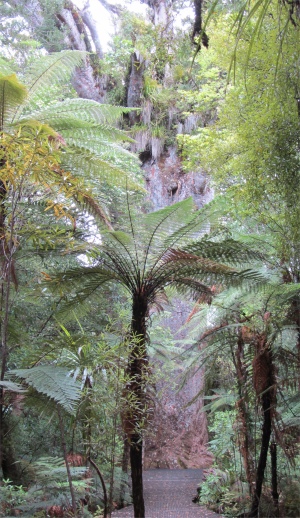 Yakas Kauri |
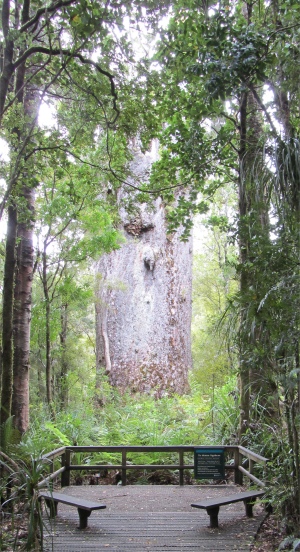 Te Matua Ngahere, "Father of the Forest" |
Further up the path I entered the presence of Tane Mahuta, "Lord of the Forest", the largest kauri tree in New Zealand and the world. This awesome tree was estimated to be 1,500 years old. It rose to 51.5m tall, with a girth of 13.8m and a wood mass of 244.5 cubic metres. The monolithic 6m wide cliff of bark before me towered up to what appeared to be an inverted broccoli that supported a complete ecological system. This tree commanded respect, and I felt honoured to be granted an audience.
I was standing there open mouthed when two Maori women appeared. They asked me what I thought about the upside down tree. After uttering all the superlatives I could muster, they carefully explained to me the legend behind it. The Maori believed that Tane, the tree, was the son of Rangi, the sky-father and Papa the earth-mother. Tane physically tore his parents apart, breaking their primal embrace to bring light, space and air into the world, and was the life-giver and all living creatures were his children. The powerful presence emanating from this majestic tree was almost tangible.
They rapidly picked up I wasn't a Kiwi; funny that. The younger of the two had a crop of jet black hair, numerous facial piercings, but few tattoos. She had spent some time in Saffron Waldron. The pair were a hoot; always giggling. "Why do so many young New Zealanders spend their OE in Britain?" I asked. "When we're young, we just want to get as far away from here as we can. We can't get any further than Britain, and besides, there is a bond between our countries," replied the woman. Fair point I thought.
They had to move on, but I remained for a while in the presence of this giant, as if pulled in by some magical spirits. Perhaps there is an element of truth in the Maori legend.
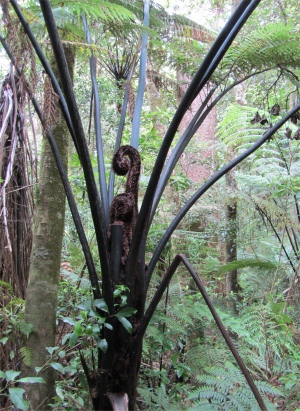 A Black Fern |
The kauri are very sensitive to their environment, and to prevent diseases reaching them from footwear, all folk walking on the trails had to first brush their soles and then sterilise them. Numerous placards abounded warning of the dangers of walking near kauri, their feeding roots lie near the surface and are easily damaged. The Maori women had also told me that at one time people had their ashes scattered at the base of these trees. This was discovered to be detrimental to the trees, so the practice has been stopped. Tane Mahuta had been fenced off, but these trails went right through groves of kauri.
A turn off the main trail took me to the Four Sisters, a graceful stand of four tress embraced together at their base. Back onto the main trail, a 30min path through an army of large trees led me to Te Matua Ngahere, "Father of the Forest", the second largest tree in New Zealand. At only 30m tall, he was much shorter than Tane Mahuta, but with a girth of 16.4m, he was the widest living kauri.
A longer 3km walk along the Yakas track took me through more dense undergrowth, which looked almost impenetrable. I pondered on the loggers who had to fight their way through this, and then struggle to remove the logs through it after felling. It can't have been an easy crust. The winds howled through the canopy and braches high above me, but at ground level I could barely feel a puff of wind. Ever since I was a child, I always found it comforting in a wood or forest when it provided shelter from the elements. I came across a dense conglomeration of trees known as Cathedral Grove. I marvelled at how complete ecosystems were flourishing within the tops of these monoliths. This longer trail ended at Yakas Kauri, the seventh largest kauri, named after a native Dalmatian bushman and gumdigger Nick Yakas.
I returned back to the car park, exchanging greetings as I passed people I had crossed paths with earlier. I exchanged a few more words with the security guard, who warned me to be careful at Trounson Kauri Park. Thieves operated there, and there was no guard there.
The route I took to Trounson Kauri Park was 8km down a gravel track. I passed areas where dwellings clung high up on banks by the track, and the whole remoteness of my surroundings brought back memories of the classic film, "Deliverance". I expected duelling banjos around every corner.
The 450-hectare park was opened in 1921 by James Trounson. His words at the time were:
"If the gift of all this bush will give pleasure to the people, if it inspires the gratitude of the Giver of all good, I shall be well repaid.
Really, my part in the matter is small, these trees were planted a thousand years before the white man came to this country, and will be here hundreds of years hence. I am only too glad to be able to hand on this bush to the Government for the pleasure of the people."
I had to take similar precautions to my footwear as I did on the previous walks. A 30min walk led me through a delightful forest threaded with streams, kauri stands and its own group of Four Sisters. It sought to restore the former richness of native biodiversity this forest once boasted, allowing people to enjoy a glimpse of what pristine kauri forests were once like. Sadly I was now getting saturated with kauri and becoming rather blas�.
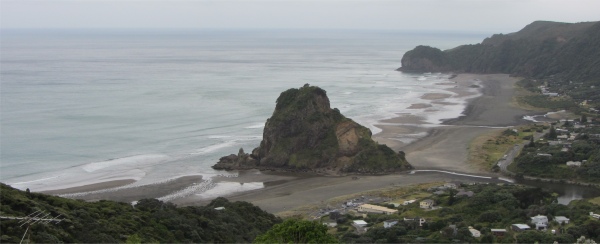 Piha Beach |
I took a right fork here and soon found myself gaining height, and in the distance I could see the vast expanse of Kaipara Harbour, a wide stretch of water about 70km long, with an exit to the Tasman Sea half way along it. I whizzed through Helensville and started through a region full of wineries. Once I was near the western side of Waitemata Harbour, on the outskirts of Auckland, I turned off to take the Scenic Drive through the Waitakere Ranges.
Auckland's western limit, 25km out from the city centre, is naturally defined by these ranges. Formed by volcanic eruptions 20 million years ago, the ranges were once cloaked in giant kauri trees. Loggers claimed most of these trees in the mid-19th century. Now covered with native bush of the regenerating rainforest, the area is important as a catchment for Auckland's water supply and as a major recreational area for the city.
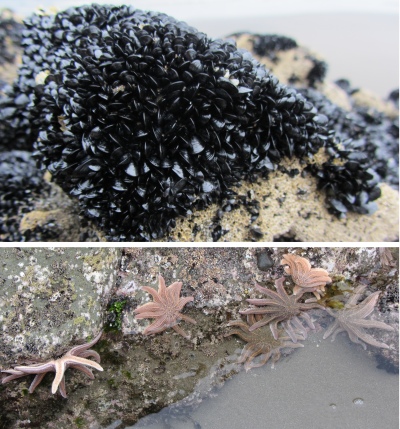 Mussels and Starfish |
The western slopes of the ranges roll down to the coast, strung along with precipitous cliffs exceeding 300m, interspersed infrequently with wild black-sand surf beaches. They have a reputation of being dangerous for swimmers due to rips and large swells. The Tasman Sea relentlessly pounds the windswept rocks and beaches; a complete contrast to the calm, gradual sloping beaches of the Hauraki Gulf to the east of Auckland. I took a turn off down to Piha, and wound my way down a seemingly endless hill which brought me to the small village, and established myself in the one and only campsite.
I wandered down to the beach, which comprised mainly darker sands than those I had already seen elsewhere. Their colouring was due to the large amounts of basalt in the vicinity. This stretch of coast is a surfer's paradise. Piha in particular was much favoured. A steady ocean swell from the southwest, combined with the way waves break on the bars and sandbanks, provides Piha's famous surf. Other factors which make good surf include the way the waves bend when they enter the bay, and the angles the waves make with the sandbanks, which caused them to "peel" so that surfers can race across the face of the unbroken wave.
A large rock towered over the beach, Lion Rock, what's left of the core of a volcano and once a Maori pa site. A short distance south stood the Camel. At the base of the "Lion", I found a clump of boulders, glistening black with clusters of tiny mussels. Dozens of starfish clung stubbornly to the rocks; I couldn't ascertain whether they were alive or not. Crabs scuttled into hiding as I circled their homes.
Along the beach, groups of teenagers were in high spirits playing rounders and volleyball. This seemed a good place to wind down, the perfect antidote to the forests and over five hours of driving that I had to endure. As I returned past the Bowling Club, I noticed that they were serving food, so I took the easy option. I detected an English twang in the middle-aged woman who served my beer. She stood back in amazement when I asked her where she hailed from. The woman had moved over here from Coventry when she was five years old, and as far as she was concerned, she spoke perfect Kiwi. One lives and learns.
I strolled back to the campsite, and went to type my blog up in the communal kitchen. A steady stream of youngsters of all nationalities poured in, to cook all hotchpotches conceivable. Some worked as teams, others as master/slaves. There didn't seem to be any connection between them, all functioning as isolated groups with very little bon homie between them. I greeted them as they entered, twitched my nostrils at the reek of burnt onions once again, and acknowledged as they left.
Eventually they were all gone, and the cleaning lady turned up, muttering that the kitchen should not be used after 10pm. It was now 11:30pm, and I apologised for still squatting here. She didn't mind, and happily worked around me. We chatted, and I soon found she was an Australian. "Me and my partner moved over here not long ago," she said, "and we just love it over here. They don't have the same attitude as over in Oz. Here they are much friendlier, and it is a slower pace of life. I'll be going back to visit my family in Sydney in February, but never to live again. I'm lucky, I was able to take early retirement. When we settled here, Tanya, the manager asked me if I could do a few hours cleaning for her. I didn't want to go back to work, and here I am now cleaning five days a week, and I've never cleaned in my life before. I used to be in charge of personnel at a large security firm, and now I am quite content with this little cleaning job." She has found her niche of happiness I thought, good for her, and I wished her good night.
